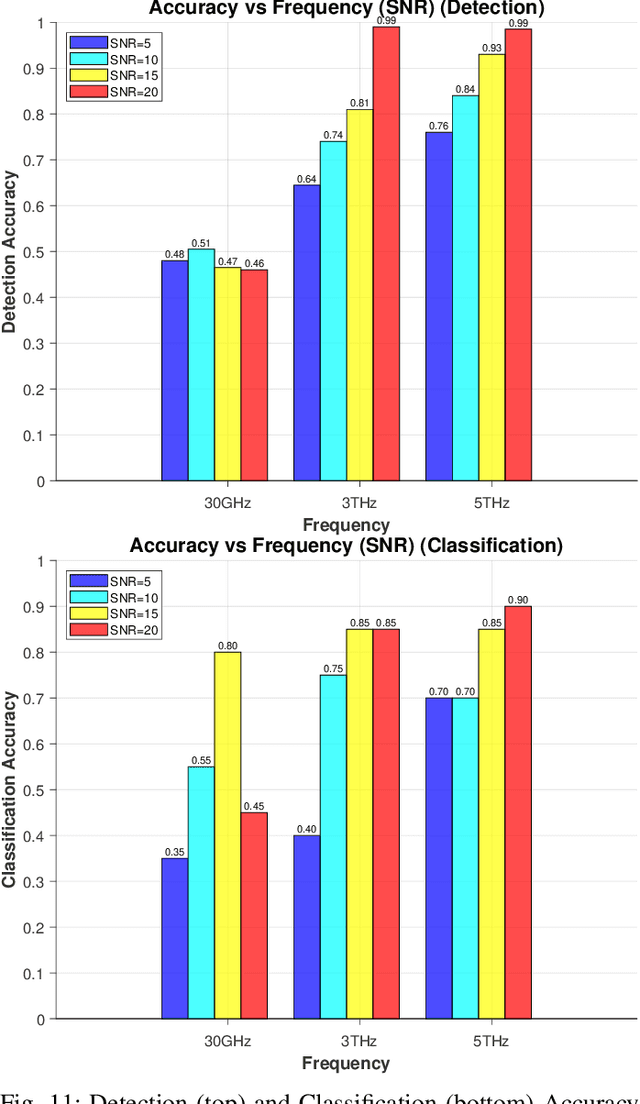Haofan Dong
Fundamental Limits of Cooperative Integrated Sensing and Communications over Low-Earth Orbit THz Satellite Channels
Oct 21, 2025Abstract:Terahertz inter-satellite links enable unprecedented sensing precision for Low Earth Orbit (LEO) constellations, yet face fundamental bounds from hardware impairments, pointing errors, and network interference. We develop a Network Cram\'er-Rao Lower Bound (N-CRLB) framework incorporating dynamic topology, hardware quality factor $\Gamma_{\text{eff}}$, phase noise $\sigma^2_\phi$, and cooperative effects through recursive Fisher Information analysis. Our analysis reveals three key insights: (i) hardware and phase noise create power-independent performance ceilings ($\sigma_{\text{ceiling}} \propto \sqrt{\Gamma_{\text{eff}}}$) and floors ($\sigma_{\text{floor}} \propto \sqrt{\sigma^2_\phi}/f_c$), with power-only scaling saturating above $\text{SNR}_{\text{crit}}=1/\Gamma_{\text{eff}}$; (ii) interference coefficients $\alpha_{\ell m}$ enable opportunistic sensing with demonstrated gains of 5.5~dB under specific conditions (65~dB processing gain, 50~dBi antennas); (iii) measurement correlations from shared timing references, when properly modeled, do not degrade performance and can provide common-mode rejection benefits compared to mismodeled independent-noise baselines. Sub-millimeter ranging requires co-optimized hardware ($\Gamma_{\text{eff}}<0.01$), oscillators ($\sigma^2_\phi<10^{-2}$), and appropriate 3D geometry configurations.
Fundamental Limits of THz Inter-Satellite ISAC Under Hardware Impairments
Sep 19, 2025Abstract:This paper establishes a theoretical framework for analyzing the fundamental performance limits of terahertz (THz) Low Earth Orbit (LEO) inter-satellite link (ISL) Integrated Sensing and Communications (ISAC) systems. We develop a unified, end-to-end signal model that, jointly captures the effects of extreme orbital dynamics, cascaded non-ideal hardware impairments, and micro-radian beam pointing errors. Through Bayesian Cram\'er-Rao Lower Bound (BCRLB) analysis, we derive the ultimate sensing accuracy for range and range-rate, revealing a quadratic ($1/f_c^2$) improvement in estimation variance with carrier frequency, which is ultimately floored by signal-dependent hardware distortion. For communication, we show that system performance is not power-limited but hardware-limited, deriving a closed-form capacity ceiling under the joint effect of phase noise and PA nonlinearity: $C_{\text{sat}} = \log_2(1 + e^{-\sigma_\phi^2}/\Gamma_{\text{eff}})$, where $\Gamma_{\text{eff}}$ is a proposed hardware quality factor. Our numerical results, based on state-of-the-art component data and the identified trade-offs, suggest that favorable operational conditions may exist in the sub-THz frequency range (200-600 GHz) where the quadratic sensing gain with frequency is balanced against hardware quality degradation. Power Amplifier (PA) nonlinearity emerges as the dominant performance bottleneck, exceeding other impairments by one to two orders of magnitude.
Martian Dust Storm Detection with THz Opportunistic Integrated Sensing and Communication in the Internet of Space (IoS)
Dec 14, 2024



Abstract:This paper presents the Mars Dust Storm Detector (MDSD), a system that leverages the THz Opportunistic Integrated Sensing and Communications (OISAC) signals between Mars surface assets (rovers and landers) to extract environmental information, particularly dust storm properties. The MDSD system utilizes the multi-parameter sensitivity of THz signal attenuation between Martian communication devices to provide rich, real-time data on storm intensity, particle characteristics, and potentially even electrification state. This approach, incorporating HITRAN spectroscopic data and Martian-specific atmospheric parameters, allows for accurate modeling and analysis. The system's ability to repurpose THz ISAC signals for environmental sensing demonstrates an efficient use of resources in the challenging Martian environment, utilizing communication infrastructure to enhance our understanding of Mars' atmospheric dynamics. The system's performance is evaluated through extensive simulations under various Node Density Factors (NDFs), comparing different interpolation algorithms for dust storm intensity mapping. Results demonstrate that linear interpolation achieves superior accuracy (correlation >0.90) at high NDFs, while nearest-neighbor and IDW algorithms maintain complete spatial coverage in sparse networks. Error analysis identifies dust particle size uncertainty as the primary contributor to estimation errors, though the system shows resilience to Martian atmospheric variations. This work extends the opportunistic use of ISAC technology to planetary exploration, contributing to both Mars atmospheric monitoring capabilities and ISAC applications in the Internet of Space (IoS).
DebriSense: Terahertz-based Integrated Sensing and Communications (ISAC) for Debris Detection and Classification in the Internet of Space (IoS)
Aug 24, 2024



Abstract:The proliferation of Low Earth Orbit (LEO) satellite constellations has intensified the challenge of space debris management. This paper introduces DebriSense-THz, a novel Terahertz-Enabled Debris Sensing system for LEO satellites that leverages Integrated Sensing and Communications (ISAC) technology. We present a comprehensive THz channel model for LEO environments, incorporating debris interactions such as reflection, scattering, and diffraction. The DebriSense-THz architecture employs machine learning techniques for debris detection and classification using Channel State Information (CSI) features. Performance evaluation across different frequencies (30 GHz-5 THz), MIMO configurations, debris densities, and SNR levels demonstrates significant improvements in debris detection and classification accuracy (95-99% at 5 THz compared to 62-81% at 30 GHz). Higher SNR configurations enhance sensing performance, particularly at higher frequencies. The system shows robust performance across various debris densities and MIMO size in the THz range, with a noted trade-off between communication reliability and sensing accuracy at lower frequencies. DebriSense-THz represents a significant advance in space situational awareness, paving the way for more effective debris mitigation strategies in increasingly congested LEO environments.
 Add to Chrome
Add to Chrome Add to Firefox
Add to Firefox Add to Edge
Add to Edge